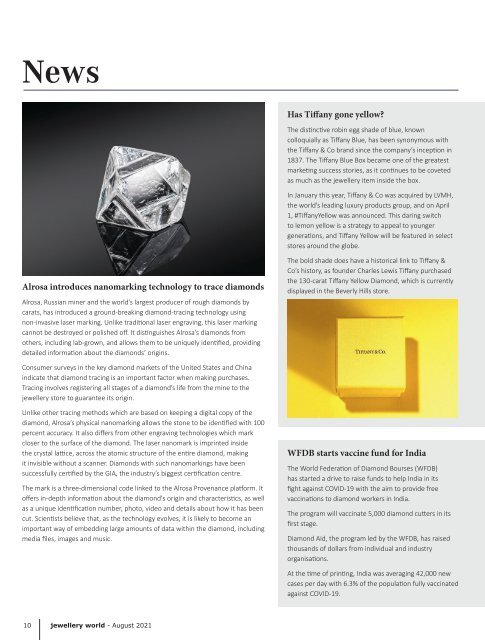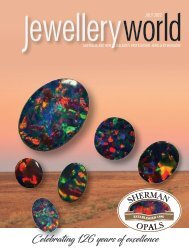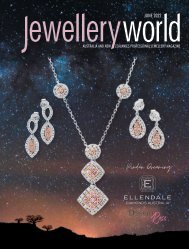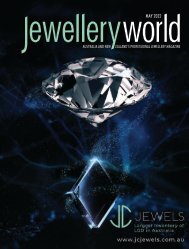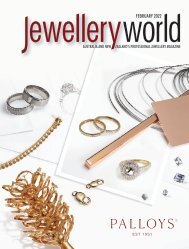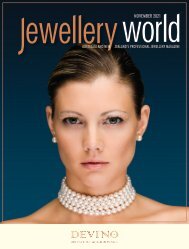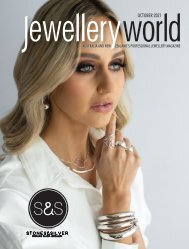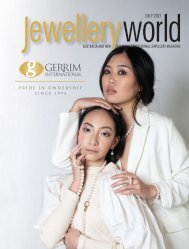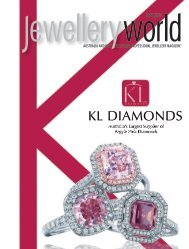Jewellery World Magazine - August 2021
You also want an ePaper? Increase the reach of your titles
YUMPU automatically turns print PDFs into web optimized ePapers that Google loves.
News<br />
Has Tiffany gone yellow?<br />
The distinctive robin egg shade of blue, known<br />
colloquially as Tiffany Blue, has been synonymous with<br />
the Tiffany & Co brand since the company’s inception in<br />
1837. The Tiffany Blue Box became one of the greatest<br />
marketing success stories, as it continues to be coveted<br />
as much as the jewellery item inside the box.<br />
In January this year, Tiffany & Co was acquired by LVMH,<br />
the world’s leading luxury products group, and on April<br />
1, #TiffanyYellow was announced. This daring switch<br />
to lemon yellow is a strategy to appeal to younger<br />
generations, and Tiffany Yellow will be featured in select<br />
stores around the globe.<br />
Alrosa introduces nanomarking technology to trace diamonds<br />
Alrosa, Russian miner and the world’s largest producer of rough diamonds by<br />
carats, has introduced a ground-breaking diamond-tracing technology using<br />
non-invasive laser marking. Unlike traditional laser engraving, this laser marking<br />
cannot be destroyed or polished off. It distinguishes Alrosa’s diamonds from<br />
others, including lab-grown, and allows them to be uniquely identified, providing<br />
detailed information about the diamonds’ origins.<br />
The bold shade does have a historical link to Tiffany &<br />
Co’s history, as founder Charles Lewis Tiffany purchased<br />
the 130-carat Tiffany Yellow Diamond, which is currently<br />
displayed in the Beverly Hills store.<br />
Consumer surveys in the key diamond markets of the United States and China<br />
indicate that diamond tracing is an important factor when making purchases.<br />
Tracing involves registering all stages of a diamond’s life from the mine to the<br />
jewellery store to guarantee its origin.<br />
Unlike other tracing methods which are based on keeping a digital copy of the<br />
diamond, Alrosa’s physical nanomarking allows the stone to be identified with 100<br />
percent accuracy. It also differs from other engraving technologies which mark<br />
closer to the surface of the diamond. The laser nanomark is imprinted inside<br />
the crystal lattice, across the atomic structure of the entire diamond, making<br />
it invisible without a scanner. Diamonds with such nanomarkings have been<br />
successfully certified by the GIA, the industry’s biggest certification centre.<br />
The mark is a three-dimensional code linked to the Alrosa Provenance platform. It<br />
offers in-depth information about the diamond's origin and characteristics, as well<br />
as a unique identification number, photo, video and details about how it has been<br />
cut. Scientists believe that, as the technology evolves, it is likely to become an<br />
important way of embedding large amounts of data within the diamond, including<br />
media files, images and music.<br />
WFDB starts vaccine fund for India<br />
The <strong>World</strong> Federation of Diamond Bourses (WFDB)<br />
has started a drive to raise funds to help India in its<br />
fight against COVID-19 with the aim to provide free<br />
vaccinations to diamond workers in India.<br />
The program will vaccinate 5,000 diamond cutters in its<br />
first stage.<br />
Diamond Aid, the program led by the WFDB, has raised<br />
thousands of dollars from individual and industry<br />
organisations.<br />
At the time of printing, India was averaging 42,000 new<br />
cases per day with 6.3% of the population fully vaccinated<br />
against COVID-19.<br />
10<br />
jewellery world - <strong>August</strong> <strong>2021</strong>


